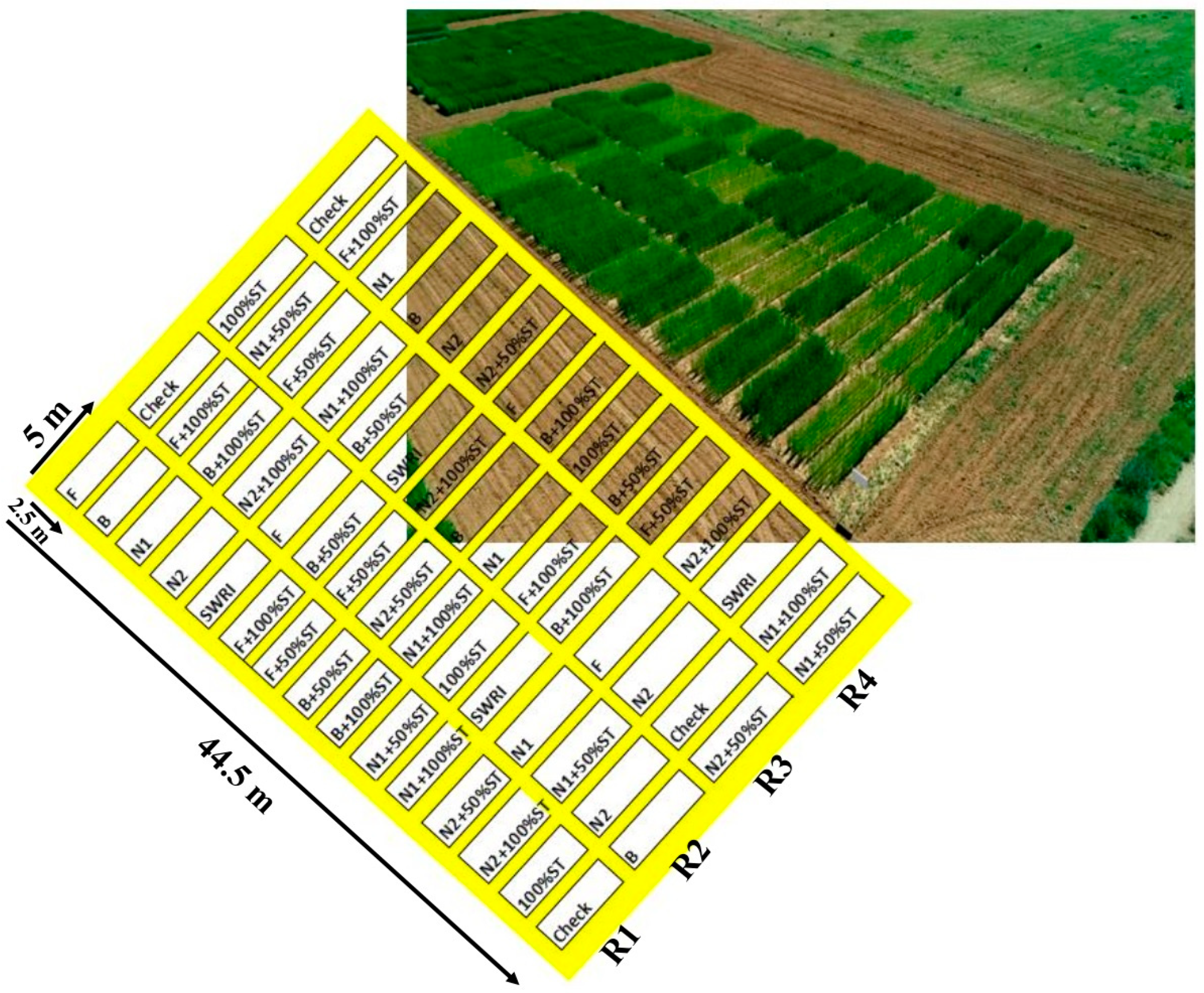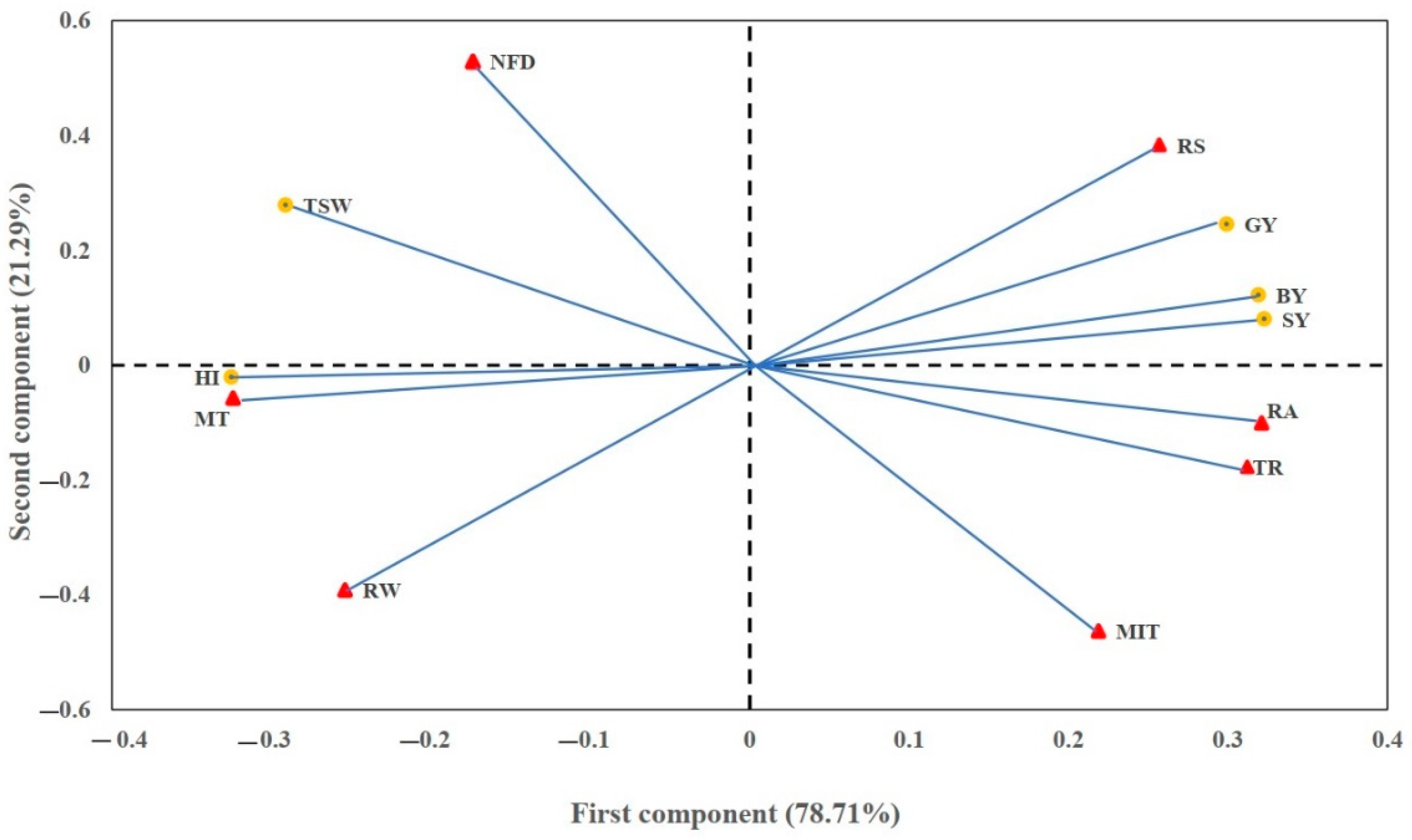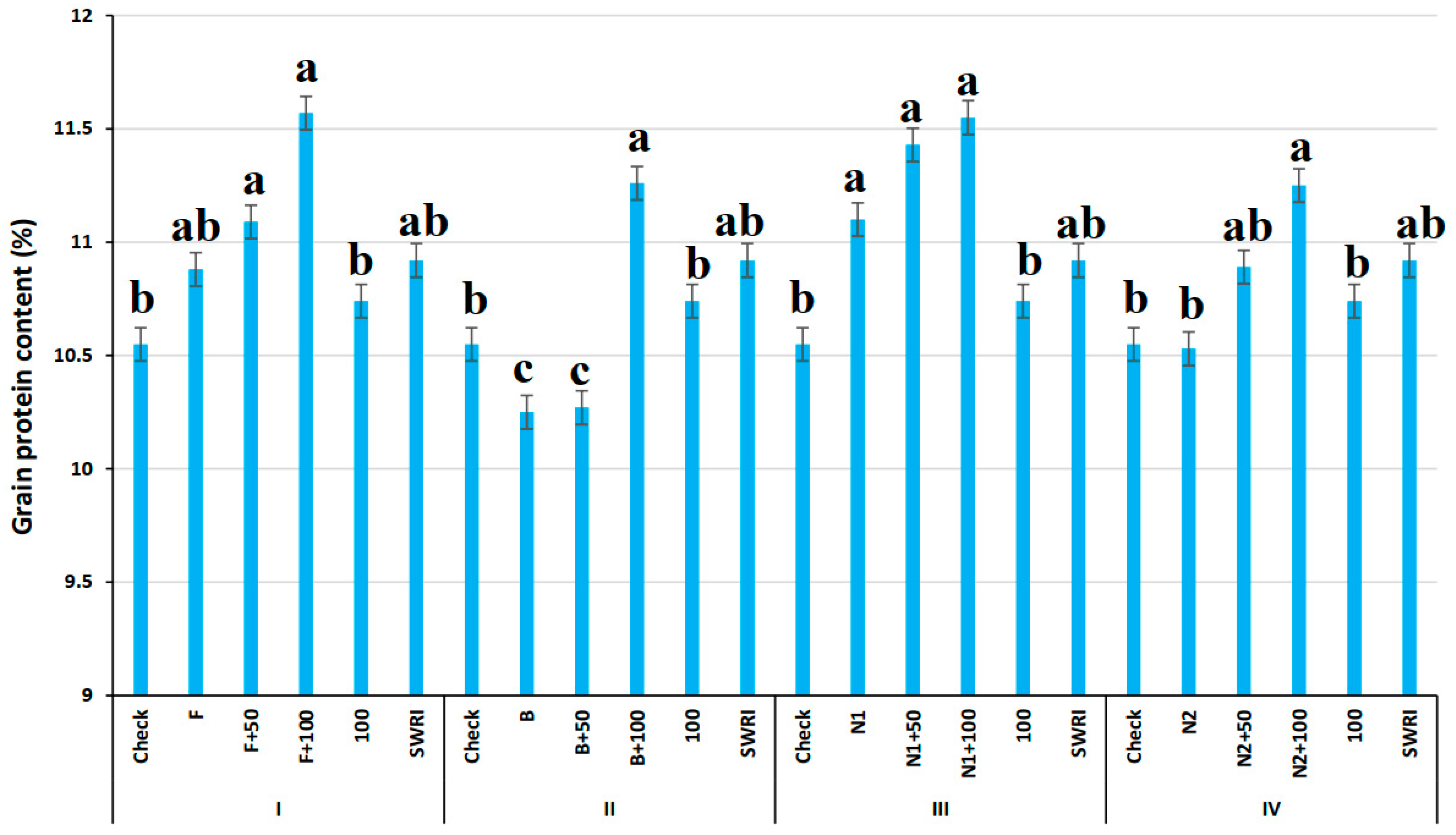Comparative Analysis of Plant Growth-Promoting Rhizobacteria (PGPR) and Chemical Fertilizers on Quantitative and Qualitative Characteristics of Rainfed Wheat
Abstract
:1. Introduction
2. Materials and Methods
2.1. Experimental Design and Treatments
2.2. Plant Analysis
2.3. Data Analysis
3. Results
3.1. Effects of Applied Biofertilizers and Their Combinations with Chemical Fertilizers on Yield Components of the Azar-2 Rainfed Cultivar
3.2. Effects of Applied Biofertilizers and Their Combinations with Chemical Fertilizers on the Qualitative Characteristics of the Azar-2 Rainfed Cultivar
4. Discussion
5. Conclusions
Supplementary Materials
Author Contributions
Funding
Data Availability Statement
Acknowledgments
Conflicts of Interest
References
- Wei, C.; Jiao, Q.; Agathokleous, E.; Liu, H.; Li, G.; Zhang, J.; Fahad, S.; Jiang, Y. Hormetic effects of zinc on growth and antioxidant defense system of wheat plants. Sci. Total Environ. 2022, 807, 150992. [Google Scholar] [CrossRef]
- Iqbal, N.; Hussain, S.; Ahmed, Z.; Yang, F.; Wang, X.; Liu, W.; Yong, T.; Du, J.; Shu, K.; Yang, W.; et al. Comparative analysis of maize–soybean strip intercropping systems: A review. Plant Prod. Sci. 2019, 22, 131–142. [Google Scholar] [CrossRef] [Green Version]
- Sedri, M.H.; Roohi, E.; Niazian, M.; Niedbała, G. Interactive Effects of Nitrogen and Potassium Fertilizers on Quantitative-Qualitative Traits and Drought Tolerance Indices of Rainfed Wheat Cultivar. Agronomy 2021, 12, 30. [Google Scholar] [CrossRef]
- Roohi, E.; Mohammadi, R.; Niane, A.A.; Niazian, M.; Niedbała, G. Agronomic Performance of Rainfed Barley Genotypes under Different Tillage Systems in Highland Areas of Dryland Conditions. Agronomy 2022, 12, 1070. [Google Scholar] [CrossRef]
- Zeng, Q.; Ding, X.; Wang, J.; Han, X.; Iqbal, H.M.N.; Bilal, M. Insight into soil nitrogen and phosphorus availability and agricultural sustainability by plant growth-promoting rhizobacteria. Environ. Sci. Pollut. Res. 2022, 29, 45089–45106. [Google Scholar] [CrossRef]
- Sun, H.; Zhang, Y.; Yang, Y.; Chen, Y.; Jeyakumar, P.; Shao, Q.; Zhou, Y.; Ma, M.; Zhu, R.; Qian, Q.; et al. Effect of biofertilizer and wheat straw biochar application on nitrous oxide emission and ammonia volatilization from paddy soil. Environ. Pollut. 2021, 275, 116640. [Google Scholar] [CrossRef]
- Xu, Q.; Ling, N.; Chen, H.; Duan, Y.; Wang, S.; Shen, Q.; Vandenkoornhuyse, P. Long-Term Chemical-Only Fertilization Induces a Diversity Decline and Deep Selection on the Soil Bacteria. mSystems 2020, 5, e00337-20. [Google Scholar] [CrossRef]
- Cig, F.; Erman, M.; Inal, B.; Bektas, H.; Sonkurt, M.; Mirzapour, M.; Ceritoglu, M. Mitigation of Drought Stress in Wheat by Bio-priming by PGPB Containing ACC Deaminase Activity. Ataturk Univ. J. Agric. Fac. 2022, 53, 51–57. [Google Scholar] [CrossRef]
- Elkelish, A.; El-Mogy, M.M.; Niedbała, G.; Piekutowska, M.; Atia, M.A.M.; Hamada, M.M.A.; Shahin, M.; Mukherjee, S.; El-Yazied, A.A.; Shebl, M.; et al. Roles of Exogenous α-Lipoic Acid and Cysteine in Mitigation of Drought Stress and Restoration of Grain Quality in Wheat. Plants 2021, 10, 2318. [Google Scholar] [CrossRef]
- Nadeem, S.M.; Naveed, M.; Zahir, Z.A.; Asghar, H.N. Plant–Microbe Interactions for Sustainable Agriculture: Fundamentals and Recent Advances. In Plant Microbe Symbiosis: Fundamentals and Advances; Springer: New Delhi, India, 2013; pp. 51–103. [Google Scholar]
- Basu, A.; Prasad, P.; Das, S.N.; Kalam, S.; Sayyed, R.Z.; Reddy, M.S.; El Enshasy, H. Plant Growth Promoting Rhizobacteria (PGPR) as Green Bioinoculants: Recent Developments, Constraints, and Prospects. Sustainability 2021, 13, 1140. [Google Scholar] [CrossRef]
- El-Sawah, A.; El-Keblawy, A.; Ali, D.; Ibrahim, H.; El-Sheikh, M.; Sharma, A.; Alhaj Hamoud, Y.; Shaghaleh, H.; Brestic, M.; Skalicky, M.; et al. Arbuscular Mycorrhizal Fungi and Plant Growth-Promoting Rhizobacteria Enhance Soil Key Enzymes, Plant Growth, Seed Yield, and Qualitative Attributes of Guar. Agriculture 2021, 11, 194. [Google Scholar] [CrossRef]
- Akhtar, N.; Ilyas, N.; Mashwani, Z.-R.; Hayat, R.; Yasmin, H.; Noureldeen, A.; Ahmad, P. Synergistic effects of plant growth promoting rhizobacteria and silicon dioxide nano-particles for amelioration of drought stress in wheat. Plant Physiol. Biochem. 2021, 166, 160–176. [Google Scholar] [CrossRef]
- Khan, N.; Bano, A.; Rahman, M.A.; Guo, J.; Kang, Z.; Babar, M.A. Comparative Physiological and Metabolic Analysis Reveals a Complex Mechanism Involved in Drought Tolerance in Chickpea (Cicer arietinum L.) Induced by PGPR and PGRs. Sci. Rep. 2019, 9, 2097. [Google Scholar] [CrossRef]
- Dal Cortivo, C.; Ferrari, M.; Visioli, G.; Lauro, M.; Fornasier, F.; Barion, G.; Panozzo, A.; Vamerali, T. Effects of Seed-Applied Biofertilizers on Rhizosphere Biodiversity and Growth of Common Wheat (Triticum aestivum L.) in the Field. Front. Plant Sci. 2020, 11, 72. [Google Scholar] [CrossRef] [Green Version]
- Kumari, B.; Mallick, M.A.; Solanki, M.K.; Solanki, A.C.; Hora, A.; Guo, W. Plant Growth Promoting Rhizobacteria (PGPR): Modern Prospects for Sustainable Agriculture. In Plant Health Under Biotic Stress; Springer: Singapore, 2019; pp. 109–127. [Google Scholar]
- Niedbała, G.; Kurasiak-Popowska, D.; Stuper-Szablewska, K.; Nawracała, J. Application of Artificial Neural Networks to Analyze the Concentration of Ferulic Acid, Deoxynivalenol, and Nivalenol in Winter Wheat Grain. Agriculture 2020, 10, 127. [Google Scholar] [CrossRef] [Green Version]
- Oleńska, E.; Małek, W.; Wójcik, M.; Swiecicka, I.; Thijs, S.; Vangronsveld, J. Beneficial features of plant growth-promoting rhizobacteria for improving plant growth and health in challenging conditions: A methodical review. Sci. Total Environ. 2020, 743, 140682. [Google Scholar] [CrossRef]
- Thomas, R.L.; Sheard, R.W.; Moyer, J.R. Comparison of Conventional and Automated Procedures for Nitrogen, Phosphorus, and Potassium Analysis of Plant Material Using a Single Digestion 1. Agron. J. 1967, 59, 240–243. [Google Scholar] [CrossRef]
- Yoshida, S.; Forno, D.A.; Cock, J.H. Laboratory Manual for Physiological Studies of Rice; CAB International: Los Banos, Philippines, 1971. [Google Scholar]
- El-Saadony, F.M.A.; Mazrou, Y.S.A.; Khalaf, A.E.A.; El-Sherif, A.M.A.; Osman, H.S.; Hafez, E.M.; Eid, M.A.M. Utilization Efficiency of Growth Regulators in Wheat under Drought Stress and Sandy Soil Conditions. Agronomy 2021, 11, 1760. [Google Scholar] [CrossRef]
- Malik, W.A.; Piepho, H.-P. Biplots: Do Not Stretch Them! Crop Sci. 2018, 58, 1061–1069. [Google Scholar] [CrossRef]
- Jin, N.; Ren, W.; Tao, B.; He, L.; Ren, Q.; Li, S.; Yu, Q. Effects of water stress on water use efficiency of irrigated and rainfed wheat in the Loess Plateau, China. Sci. Total Environ. 2018, 642, 1–11. [Google Scholar] [CrossRef]
- Camaille, M.; Fabre, N.; Clément, C.; Ait Barka, E. Advances in Wheat Physiology in Response to Drought and the Role of Plant Growth Promoting Rhizobacteria to Trigger Drought Tolerance. Microorganisms 2021, 9, 687. [Google Scholar] [CrossRef]
- Lu, H.; Xue, J.; Guo, D. Efficacy of planting date adjustment as a cultivation strategy to cope with drought stress and increase rainfed maize yield and water-use efficiency. Agric. Water Manag. 2017, 179, 227–235. [Google Scholar] [CrossRef]
- Rockström, J.; Barron, J. Water productivity in rainfed systems: Overview of challenges and analysis of opportunities in water scarcity prone savannahs. Irrig. Sci. 2007, 25, 299–311. [Google Scholar] [CrossRef]
- Rokhafrouz, M.; Latifi, H.; Abkar, A.A.; Wojciechowski, T.; Czechlowski, M.; Naieni, A.S.; Maghsoudi, Y.; Niedbała, G. Simplified and Hybrid Remote Sensing-Based Delineation of Management Zones for Nitrogen Variable Rate Application in Wheat. Agriculture 2021, 11, 1104. [Google Scholar] [CrossRef]
- Tilling, A.K.; O’Leary, G.J.; Ferwerda, J.G.; Jones, S.D.; Fitzgerald, G.J.; Rodriguez, D.; Belford, R. Remote sensing of nitrogen and water stress in wheat. Field Crop. Res. 2007, 104, 77–85. [Google Scholar] [CrossRef]
- Ullah, N.; Ditta, A.; Imtiaz, M.; Li, X.; Jan, A.U.; Mehmood, S.; Rizwan, M.S.; Rizwan, M. Appraisal for organic amendments and plant growth-promoting rhizobacteria to enhance crop productivity under drought stress: A review. J. Agron. Crop Sci. 2021, 207, 783–802. [Google Scholar] [CrossRef]
- Zafar-ul-Hye, M.; Danish, S.; Abbas, M.; Ahmad, M.; Munir, T.M. ACC Deaminase Producing PGPR Bacillus amyloliquefaciens and Agrobacterium fabrum along with Biochar Improve Wheat Productivity under Drought Stress. Agronomy 2019, 9, 343. [Google Scholar] [CrossRef] [Green Version]
- Zia, R.; Nawaz, M.S.; Yousaf, S.; Amin, I.; Hakim, S.; Mirza, M.S.; Imran, A. Seed inoculation of desert-plant growth-promoting rhizobacteria induce biochemical alterations and develop resistance against water stress in wheat. Physiol. Plant. 2021, 172, 990–1006. [Google Scholar] [CrossRef]
- Ansari, F.A.; Jabeen, M.; Ahmad, I. Pseudomonas azotoformans FAP5, a novel biofilm-forming PGPR strain, alleviates drought stress in wheat plant. Int. J. Environ. Sci. Technol. 2021, 18, 3855–3870. [Google Scholar] [CrossRef]
- Danish, S.; Zafar-ul-Hye, M. Co-application of ACC-deaminase producing PGPR and timber-waste biochar improves pigments formation, growth and yield of wheat under drought stress. Sci. Rep. 2019, 9, 5999. [Google Scholar] [CrossRef] [Green Version]
- Khan, N.; Bano, A.; Shahid, M.A.; Nasim, W.; Ali Babar, M. Interaction between PGPR and PGR for water conservation and plant growth attributes under drought condition. Biologia 2018, 73, 1083–1098. [Google Scholar] [CrossRef]
- Besharati, H.; Aliasgharzad, N.; Khavazi, K.; Asadi Rahmani, H. Soil Biology and Biotechnology. In The Soils of Iran; Roozitalab, M., Siadat, H., Farshad, A., Eds.; Springer: Cham, Switzerland, 2018; pp. 189–211. [Google Scholar]
- Chaechian, F.; Pasari, B.; Sabaghpour, S.H.; Rokhzadi, A.; Mohammadi, K. Yield, Yield Components and Evaluation Indices in Wheat–Chickpea Intercropping as Affected by Different Sowing Methods and Ratios and Biofertilizer Inoculation. Gesunde Pflanz. 2022, 1, 1–11. [Google Scholar] [CrossRef]
- Jafari, H.; Heidari, G.; Khalesro, S. Effects of Supplemental Irrigation and biofertilizers on Yield and Yield Components of Dryland wheat (Triticum aestivum L.). J. Agric. Sci. Sustain. Prod. 2019, 29, 173–187. [Google Scholar]
- Rashnoo, A.; Movahedi, Z.; Rostami, M.; Ghabooli, M. Piriformospora indica Culture Filtrate and Biofertilizer (Nitrokara) Promote Chicory (Cichorium intybus L.) Growth and Morpho-physiological Traits in an Aeroponic System and Soil Culture. Int. J. Hortic. Sci. Technol. 2020, 7, 353–363. [Google Scholar] [CrossRef]
- Varinderpal-Singh; Sharma, S.; Kunal; Gosal, S.K.; Choudhary, R.; Singh, R.; Adholeya, A. Bijay-Singh Synergistic Use of Plant Growth—Promoting Rhizobacteria, Arbuscular Mycorrhizal Fungi, and Spectral Properties for Improving Nutrient Use Efficiencies in Wheat (Triticum aestivum L.). Commun. Soil Sci. Plant Anal. 2020, 51, 14–27. [Google Scholar] [CrossRef]
- Artyszak, A.; Gozdowski, D. The Effect of Growth Activators and Plant Growth-Promoting Rhizobacteria (PGPR) on the Soil Properties, Root Yield, and Technological Quality of Sugar Beet. Agronomy 2020, 10, 1262. [Google Scholar] [CrossRef]
- Song, C.; Jin, K.; Raaijmakers, J.M. Designing a home for beneficial plant microbiomes. Curr. Opin. Plant Biol. 2021, 62, 102025. [Google Scholar] [CrossRef]
- Wang, L.; Li, X. Steering soil microbiome to enhance soil system resilience. Crit. Rev. Microbiol. 2019, 45, 743–753. [Google Scholar] [CrossRef]



| Year | Mn | Fe | Cu | Zn | Kav | Pav | Texture | Sand | Silt | Clay | NTot | T.N.V. | OC | Sp | pH | Ec × 10−3 |
|---|---|---|---|---|---|---|---|---|---|---|---|---|---|---|---|---|
| (mg/kg) | (%) | |||||||||||||||
| 2016–2017 | 13.4 | 6.62 | 0.68 | 0.67 | 363 | 8.6 | Clay Loam | 29 | 33 | 38 | 0.10 | 18 | 0.87 | 42.24 | 7.91 | 0.618 |
| 2017–2018 | 14.2 | 5.98 | 0.73 | 0.65 | 299 | 11.72 | Clay Loam | 20 | 42 | 38 | 0.07 | 18 | 0.73 | 40.24 | 8.20 | 0.559 |
| 2018–2019 | 12.2 | 5.32 | 0.78 | 0.81 | 334 | 10.1 | Clay Loam | 30 | 32 | 39 | 0.11 | 16 | 0.65 | 40.11 | 7.62 | 0.512 |
| Treatment | Biological Yield | Grain Yield | Straw Yield | 1000-Seed Weight | |
|---|---|---|---|---|---|
| 1 | Control | 4716 e | 1822 e | 2894 d | 41.86 bc |
| 2 | F | 4856 e | 1810 e | 4034 ab | 41.54 bcd |
| 3 | B | 5034 e | 1885 e | 3525 bcd | 43.28 a |
| 4 | N1 | 4974 e | 1920 e | 3597 bc | 41.50 bcd |
| 5 | N2 | 5089 e | 1896 e | 3536 bc | 42.64 ab |
| 6 | SWRI | 4485 e | 1678 e | 3287 cd | 41.03 cd |
| 7 | F + 100% ST | 7088 abcd | 2765 ab | 3980 ab | 39.65 effg |
| 8 | F + 50% ST | 6338 cd | 2337 d | 4313 a | 40.51 cde |
| 9 | B + 100% ST | 7320 ab | 2705 abc | 4304 a | 38.97 fg |
| 10 | B + 50% ST | 6266 d | 2334 d | 4276 a | 39.55 efg |
| 11 | N1 + 100% ST | 7177 abc | 2846 a | 3853 abc | 39.00 fg |
| 12 | N1 + 50% ST | 6560 bcd | 2489 bcd | 3729 abc | 39.55 efg |
| 13 | N2 + 100% ST | 7400 ab | 2847 a | 4010 ab | 40.45 cde |
| 14 | N2 + 50% ST | 6406 cd | 2422 cd | 3608 bc | 40.21 def |
| 15 | 100% ST | 7593 a | 2877 a | 3728 abc | 38.31 g |
| LSD 5% | 1186 | 319 | 639 | 1.36 | |
| Climatic Factor | Year | |||||
|---|---|---|---|---|---|---|
| 2016–2017 | 2017–2018 | 2018–2019 | ||||
| Total rainfall (mm) | 336 | 339.5 | 466.5 | |||
| Rainfall in autumn (mm) | 39 | 24.5 | 155 | |||
| Rainfall in winter (mm) | 150 | 157.5 | 149 | |||
| Rainfall in spring (mm) | 147 | 46.4 | 162.5 | |||
| Mean temperature (°C) | 9.53 | 10.2 | 8.3 | |||
| Minimum of temperature (°C) | −26 | −22 | −18.6 | |||
| Number of frosty days | 128 | 103 | 92 | |||
| Grain yield (kg/ha) | ||||||
| Noninoculated control | 2017 | 1264 | 2184 | |||
| Fertilizer treatments | Grain yield change in treatments versus check (kg/ha) | Total grain yield change of treatments versus control during three cropping seasons (kg/ha) | Group * | Grain yield change in fertilizer groups versus noninoculated control (kg/ha) | ||
| F | +83 | −195 | +78 | −11 | I | 16 |
| B | +3 | −38 | +225 | +63 | ||
| N1 | +330 | −37 | +334 | +98 | ||
| N2 | −50 | −214 | +484 | +78 | ||
| SWRI | +15 | −291 | −155 | −144 | ||
| F+ 50% ST | +390 | +826 | +327 | +514 | II | 574 |
| B + 50% ST | +288 | +814 | +436 | +513 | ||
| N1 + 50% ST | +345 | +736 | +920 | +667 | ||
| N2 + 50% ST | +178 | +738 | +884 | +600 | ||
| F + 100% ST | +865 | +990 | +974 | +943 | III | 969 |
| B + 100% ST | +695 | +1015 | +939 | +883 | ||
| N1 + 100% ST | +968 | +977 | +1126 | +1024 | ||
| N2 + 100% ST | +760 | +1241 | +1076 | +1026 | ||
| 100% ST | +793 | +1065 | +1309 | +1056 | IV | 1056 |
| No | Treatment | Concentration in Flag Leaves (%) | |
|---|---|---|---|
| Potassium | Phosphorous | ||
| 1 | Control | 1.94 a | 0.36 a |
| 2 | F | 1.92 ab | 0.28 bcd |
| 3 | B | 1.82 abc | 0.27 bcd |
| 4 | N1 | 1.82 abc | 0.27 bcd |
| 5 | N2 | 1.87 abc | 0.28 bcd |
| 6 | SWRI | 1.84 abc | 0.27 bcd |
| 7 | F + 100% ST | 1.85 abc | 0.27 bcd |
| 8 | F + 50% ST | 1.77 abcd | 0.24 cd |
| 9 | B + 100% ST | 1.81 abc | 0.27 bcd |
| 10 | B + 50% ST | 1.76 bcd | 0.28 bcd |
| 11 | N1 + 100% ST | 1.76 bcd | 0.30 bc |
| 12 | N1 + 50% ST | 1.75 bcd | 0.29 bc |
| 13 | N2 + 100% ST | 1.59 d | 0.23 d |
| 14 | N2 + 50% ST | 1.71 cd | 0.25 bcd |
| 15 | 100% ST | 1.82 abc | 0.33 ab |
| LSD 5% | 0.175 | 0.063 | |
Publisher’s Note: MDPI stays neutral with regard to jurisdictional claims in published maps and institutional affiliations. |
© 2022 by the authors. Licensee MDPI, Basel, Switzerland. This article is an open access article distributed under the terms and conditions of the Creative Commons Attribution (CC BY) license (https://creativecommons.org/licenses/by/4.0/).
Share and Cite
Sedri, M.H.; Niedbała, G.; Roohi, E.; Niazian, M.; Szulc, P.; Rahmani, H.A.; Feiziasl, V. Comparative Analysis of Plant Growth-Promoting Rhizobacteria (PGPR) and Chemical Fertilizers on Quantitative and Qualitative Characteristics of Rainfed Wheat. Agronomy 2022, 12, 1524. https://doi.org/10.3390/agronomy12071524
Sedri MH, Niedbała G, Roohi E, Niazian M, Szulc P, Rahmani HA, Feiziasl V. Comparative Analysis of Plant Growth-Promoting Rhizobacteria (PGPR) and Chemical Fertilizers on Quantitative and Qualitative Characteristics of Rainfed Wheat. Agronomy. 2022; 12(7):1524. https://doi.org/10.3390/agronomy12071524
Chicago/Turabian StyleSedri, Mohammad Hossein, Gniewko Niedbała, Ebrahim Roohi, Mohsen Niazian, Piotr Szulc, Hadi Asadi Rahmani, and Vali Feiziasl. 2022. "Comparative Analysis of Plant Growth-Promoting Rhizobacteria (PGPR) and Chemical Fertilizers on Quantitative and Qualitative Characteristics of Rainfed Wheat" Agronomy 12, no. 7: 1524. https://doi.org/10.3390/agronomy12071524
APA StyleSedri, M. H., Niedbała, G., Roohi, E., Niazian, M., Szulc, P., Rahmani, H. A., & Feiziasl, V. (2022). Comparative Analysis of Plant Growth-Promoting Rhizobacteria (PGPR) and Chemical Fertilizers on Quantitative and Qualitative Characteristics of Rainfed Wheat. Agronomy, 12(7), 1524. https://doi.org/10.3390/agronomy12071524









